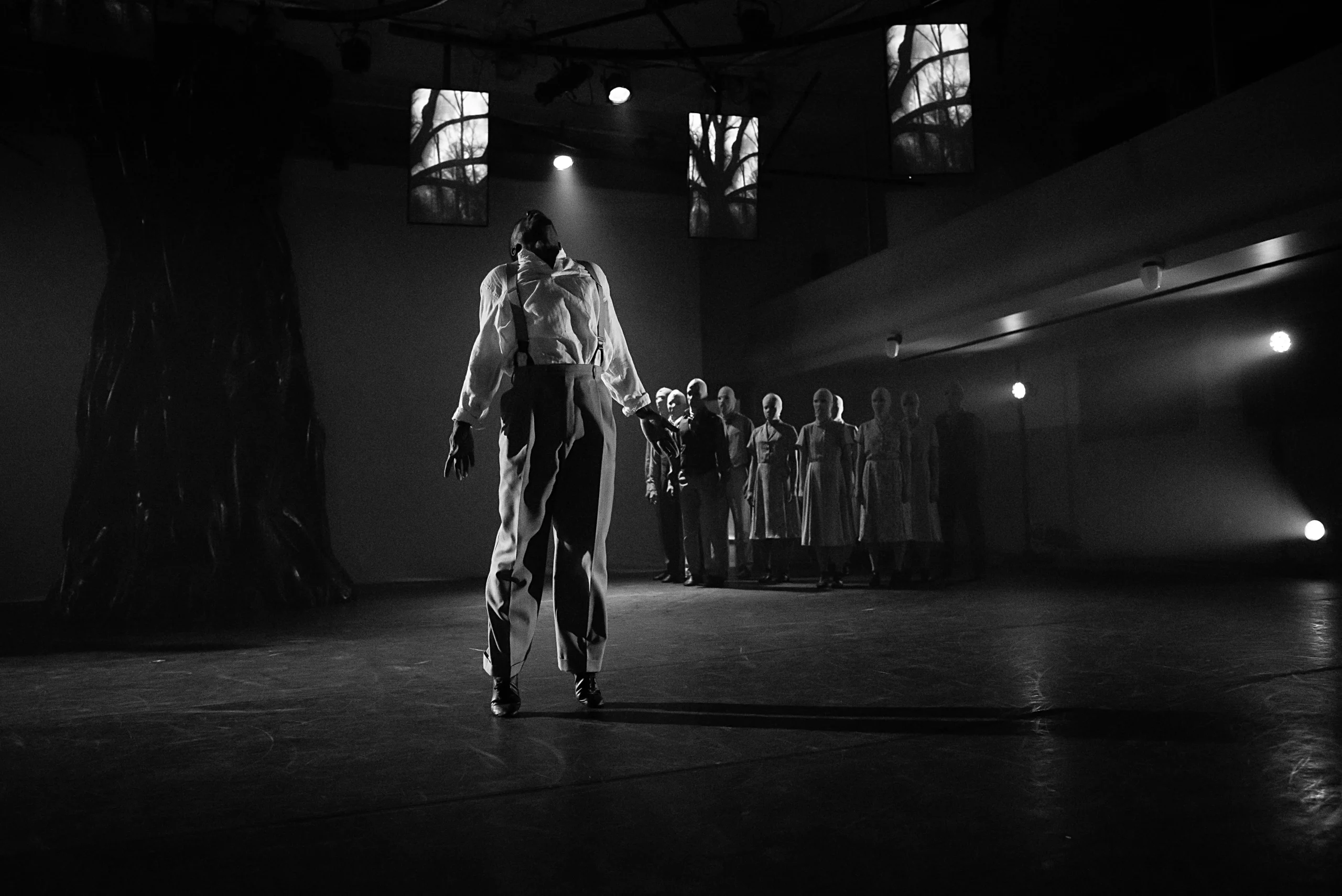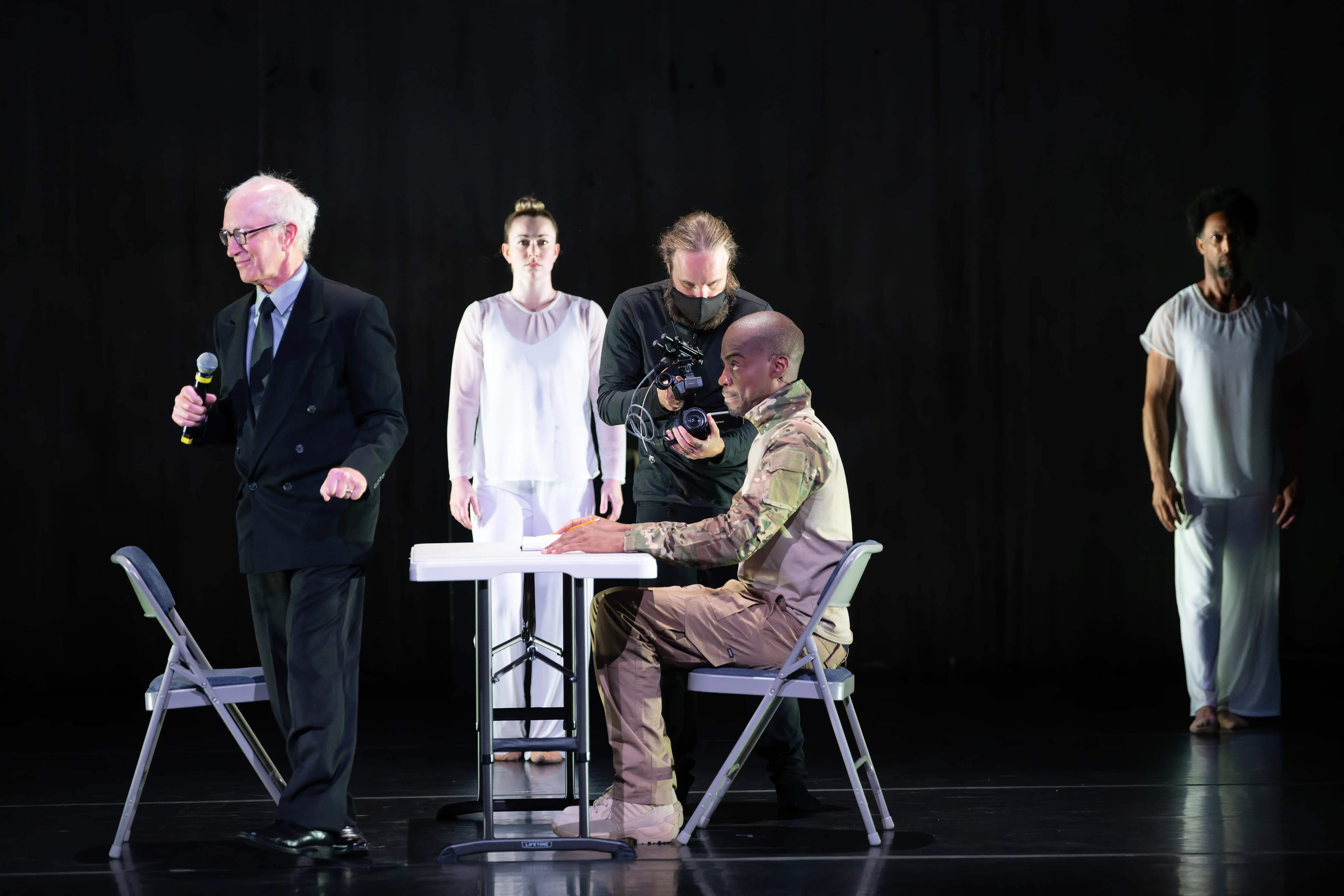
Responses edited for length and clarity
Congratulations, first, on the completion of the Trilogy. It stands out for so many reasons, as a testament to not just your expertise, but also the power of refusing to skirt the edges of injustice — saying, we are going to make unspeakable things present and spoken, and what can that do? What can that give us? The fact that you don’t take grazing blows at these issues really makes viewers walk away feeling changed by the work. Did you think to yourself, at any point around the beginning of creating the trilogy, “To what degree am I going to show the reality of violence against black Americans to my audiences without overtures or smoothing over or allegory?”
Donald Byrd: I don’t think it ever occurred to me that I would not show things if that was the right thing to do, or the most effective thing to do in terms of putting this forward. The thing that I thought about the most was not to have the pieces be so aestheticized that you actually forget that it really is about a kind of violence.

DLAR: I see. So, given that concern, how does dance work to reconcile or process such acts of violence, like lynching or mass shootings, through movement? That movement is so nuanced, so sensual, so full of purpose… It’s almost like the medium feels at odds with the content, which is random, violent, senseless. But then, when you see it on stage, you’re like, oh, my gosh, this totally works. That’s something mesmerizing to me, and I don’t understand it at all.
Strange Fruit image by Marcia Davis

DB: That’s always a question that comes up for people about, well, how can dance address these things? Most people think of dance as kind of frivolous, that it does really well with happy things. It’s much easier to do. I’ve always been interested in wanting to find ways that dance could engage with more, with darker issues or themes. In my life and how I was introduced to dance, that was always out there, that dance could do these things.
Grief image by Marcia Davis
Dance could do these things.

DB: Dance can actually address a broad range of issues, and it should not be confined to things that are upbeat or happy or just so abstract that I can just kind of get lost in the abstraction. I think that one of the reasons that American dance in particular went towards abstraction was because of what happened during the McCarthy era.
Artists were being targeted, so to speak, for making work, and getting blacklisted. By making the work abstract, there was a way to get around that… “Well, it’s just these patterns and things, you know, so I don’t know what you’re talking about…” I don’t know if people were conscious that that’s what they were doing, avoiding the controversy that the content of their work would stir up. By making it more opaque, they sidestepped those things.
As part of my investigation of this art form, I have certainly explored abstraction in my early experience with modern dance, with dance where the content was about things that affect us in our lives as opposed to things that were removed from it. That’s always been important to me.
I started doing it fairly early on in my career. I think The Minstrel Show was the first time that I directly “went there.” The Minstrel Show was quite controversial, and it was, in some ways, frightening in terms of how people responded to it and how I felt. And sometimes I would go, What the hell… am I doing right by doing that? Over time, I’ve leaned into doing this work. I don’t feel cowed by the possibility that it will hit people negatively.
Minstrel Show image by Spectrum Dance Theater

Related to moving from an abstraction into something that exists in the world as we see it — you mentioned the word “targeted,” so I wanted to jump to talking about TARGETED, which is one of the three pieces in the trilogy. It specifically looks at targeted violence against Black and Brown Americans. When you’re talking about targeted violence, do you feel like this piece, in a way, is also a targeted response to that violence? That it asks audiences to consider themselves as relevant to that conversation, and at a time when many people outside marginalized communities are only hearing about these things in a statistical format or reading headlines?
Targeted image by Marcia Davis

DB: I couldn’t have said it any better. One of the things I was after with that piece was this idea… I wrote this essay about the rhetoric of the kind of targeted violence and, you know, “the Great Replacement Theory.” It puts its agenda forward in a subversive kind of way, in a kind of subliminal way. One of the things that I wanted to do with the piece was to bring that stuff that was underneath the surface, that’s not really being said or articulated, to the surface. To know it.
The essay was called “Do Not Sing This Song.” In order to combat [hatred], you have to learn the language of it. So you learn the song of it. You are then able to recognize it when you hear it. How it cut, it morphed over time, it changes, but it’s still there. Once you know the song, then you start to recognize how it’s manifesting itself in other ways. And therefore, you can actually take action toward combating it. I’m not giving you a prescription for what you should do or how you should do it. It’s mostly about raising consciousness and awareness, and if you are a moral and ethical person, then you will do something.
People say, But you’re preaching to the choir! And I go, Yes, you know, the choir deserves to be preached to as well! Just because you’re preaching to the choir, it doesn’t mean it’s less impactful.
Grief image by Marcia Davis

I think that preaching to the choir is fortifying. We need to hear that as well. It’s so important. As long as we’re talking about choirs… in Strange Fruit, which draws its name from the poem by Meeropol, and then also the song by Billie Holiday, one of the most compelling elements of the piece is the music — the spirituals play a significant role in creating that interior space that you’re bringing audiences into. Did you feel a difference between creating a piece like this that is scored by music that’s really, structurally, about community, with a call and response aspect and about solidarity, rather than other musical works that you may have drawn from in the past, whether those were instrumental or vocal, ones not created specifically with that idea of community in mind?
Strange Fruit image by Marcia Davis

DB: Because that piece is so much focused on Blackness, you know, American Blackness, those negro spirituals or the structure, you mentioned call and response… I felt it had to be a part of it. One of the things that I did in terms of my research — I went to all of these field recordings. This father and son…
Targeted image by Marcia Davis
The Lomaxes.

DB: The Lomaxes, yeah. And I listened to a lot of the recordings that they had done.
I also wanted it to not be, and I don’t mean this in a kind of disparaging kind of way, but the kind of Black dance that comes out of the Ailey tradition and uses the music like that. I would look for other elements that could work as part of it. The grounding element was, in fact, the spirituals. There’s a singer-actor that I work with, Josie Howell. She has an incredible expressive voice. I would play things for her and say, oh, this is the Lomax, which is an older version. She goes, well, I know a version of that I learned in church! And we’d work through it.
In Strange Fruit, that female mystical character who shows up, which I called “She Who Sees,” is very much inspired by Octavia Butler’s writing. Somebody who can move through time and carry Africanness with her. I thought for that character that those spirituals would be central to her.
Targeted image by Marcia Davis

It’s so incredible to hear about how organically music like that supports collaboration. It just does. That’s my experience as well, of just being in spaces where that music is played and valued.
Grief image by Marcia Davis

DB: I think at the heart much of the work that I do, there’s history and research. Research and history and an acknowledgement of history in one way or another, is an important part of what I do. Recently, in particular, historical things in these pieces has been really important.
Targeted image by Marcia Davis

I have one final question for you, because we’re getting to the end of our time, about history. Recently, we’ve seen protests on college campuses related to violence in the Middle East, and we’ve seen responsive criticisms of these people showing their grief in ways that institutions find unacceptable, because it’s “disruptive.”As I was considering what I wanted to ask you, I kept thinking about Mamie Till-Mobley — the focus of Grief — and the ways that she showed her grief that were considered unacceptable. That was through an open-casket funeral for her murdered son. That expression was crucial, in the end, to showing Americans and the world the truth about race-based violence in the United States. When you watch the news, or when you’re listening to pundits trying to wrap their heads around why college kids are being so loud about this stuff, do you feel like people understand the power of disruptive protest any more than they did in Mamie Till-Mobley’s time? Do you feel like that’s changed, or that it’s improving at all?
Grief image by Marcia Davis

DB: No, I don’t. I mean, that’s an interesting question because I think people don’t really understand it. Who wants to be disrupted? What’s being disrupted is their sense of safety. You know, the disruption makes them feel unsafe. That’s a word that gets used a lot these days. I don’t feel safe. Well, who said you would feel safe? When, at what time in history have people felt safe? That sense of being unsafe is actually the catalyst for change, I believe.
In 1968, I was actually on the campus at Columbia. I saw a lot of things happening. I didn’t understand it the way I understand it now. I mean, it could have been about anything, in some ways — what it was about then was Vietnam. There are always significant events that give young people an opportunity to scream, which they need to, and they should, because they draw our attention to the issues in a way that sometimes the person sitting safely in their living room won’t notice. This “disruptiveness” that college students are doing and young people are doing, actually, it facilitates change.
Strange Fruit image by Marcia Davis
2025 David Lieberman Artist’s Representatives. All Rights Reserved.
